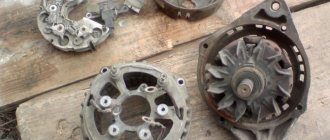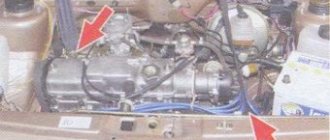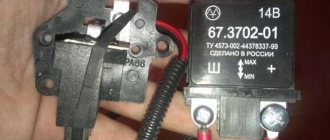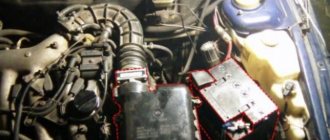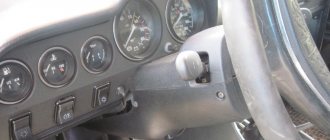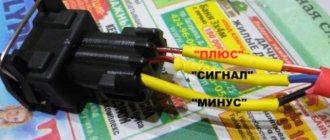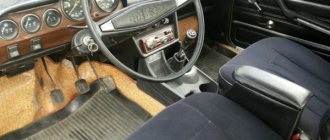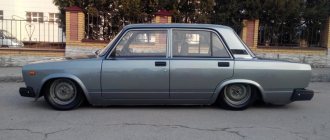As a rule, unscrewing the crankshaft pulley bolt is quite difficult. This is due to the fact that when you try to unscrew the bolt, your crankshaft will rotate. And this could be a problem. If you just decide to change the timing belt or oil seal, then nothing bad will happen. If your timing belt breaks and you rotate the crankshaft, not knowing whether the valves on your engine are bending, there is no point in describing the consequences
I'll tell you 3 ways to remove the pulley. They are suitable for cars with a classic engine arrangement. Of course, if you have a special device that fixes the pulley, then everything will turn out very simple. But most likely, since you are reading this article, you do not have the device.
The easiest way to unscrew the crankshaft pulley bolt is to use a pneumatic impact wrench, the kind that is used at tire shops. It is advisable that the compressor pressure be more than 7 bar. It is much more efficient to unscrew a bolt by briefly pressing the trigger of the impact wrench. The key is to create powerful jerks rather than prolonged rotational impact. Most likely, if you have a good impact wrench, the bolt will come out right away.
The next method is to unscrew the crankshaft pulley bolt using the starter. The method is also quite simple, the main thing is not to be afraid) We put the required head with a long collar on the crankshaft bolt. The driver needs to be rested against the floor or the suspension arm. Everything must be done so that when the starter turns the crank, it immediately hits the floor or lever. You only need to use a hex head. Under no circumstances should a 12-sided one be used, it can cut off the edges of the bolt, and this is a huge problem. You need to turn off the spark plugs. Let's try. We briefly turn the starter and go see the result. We try to manually unscrew the bolt with a wrench; if that doesn’t work, turn it with the starter again. Usually everything works out the second or third time.
This method will require more labor. Each automatic transmission has a small hatch through which the bolts connecting the flywheel and fluid coupling are unscrewed. So, if you open this hatch and insert the assembly into the flywheel teeth, you will be able to block the crankshaft. Accordingly, you can unscrew the crankshaft pulley bolt without any problems.
When the bolt is unscrewed, all that remains is to remove the pulley itself. If it cannot be removed by hand, use any universal puller. It is not recommended to knock down the pulley with a hammer; the metal there is very delicate. That's all.
The author of the article sincerely hopes that he helped cope with the problem, which sometimes takes a lot of time and nerves. Good luck, friend .
Every second car enthusiast who tries to repair his favorite four-wheeled friend with his own hands has encountered the problem of how to remove the crankshaft pulley. After reading the instructions in the maintenance and repair manual, at first glance, the procedure does not seem complicated, however, when you first try to unscrew the ill-fated bolt, it turns out that this is not so easy. It is completely unclear how to fix the crankshaft so that it does not rotate. Another problem is where is the best way to get to the treasured bolt. Removing the crankshaft pulley causes a lot of trouble because it is too tight. There is a high probability of damaging many parts of the engine compartment or the paintwork of the body.
Basic faults
There can only be three main faults with the timing belt:
- violation of the integrity of the structure;
- under- or overtension;
- break.
In the first case, the belt may simply delaminate, as evidenced by dangling reinforcing threads. In addition, belt teeth are often cut off. These problems are the result of mechanical damage, improper adjustment:
- camshaft stars;
- crankshaft pulley;
- toothed roller;
- pumps;
- tension roller.
The tension roller is designed to tension the belt by rotating around its own eccentric axis. If it is not adjusted correctly, the belt may be too tight, which will sooner or later render it unusable. The same problem will occur if the belt is loose.
The most unpleasant surprise, especially on the road, is a broken timing belt. In this case, the engine will immediately stall, and it will be possible to start it only by installing a new belt.
We exhale, we are not in danger of bending the valves
If you have an 8-valve engine, then bending the valves and replacing them, as a rule, does not threaten you, but if the “head” is 16-valve, you are definitely guaranteed to replace these elements. However, in this article we will look at how to change the timing belt on a younger brother, when a breakdown does not entail any unpleasant consequences, and all work can be carried out almost in the field and with minimal knowledge.
Major breakdowns
There are three main types of timing belt failure:
- The integrity of the belt structure is compromised - in this case, the belt delaminates, and the internal threads on its surface become visible to the naked eye. These problems occur due to mechanical damage or due to incorrect adjustment. This belt must be replaced immediately.
- Over-tension or under-tension of the belt - the tension roller is responsible for the degree of belt tension, which allows the belt to rotate around its own axis and allows it to be adjusted correctly. If the belt is too tight or too loose, it will fall into an indecent state very quickly.
- A break is the most unpleasant situation that can happen on the road with a timing belt. In this case, the engine will completely stall and it will be possible to start it again only by installing a new element.
Why is replacement needed?
The manufacturer recommends replacing the timing belt in a Lada Kalina car every 50 thousand kilometers. However, this figure is provided for a standard part, and given the quality of spare parts in our stores, it is better to replace it every 30 thousand km.
It is advisable to visually inspect the belt at least once a month by removing the protective cover. If the slightest mechanical damage or deformation is detected, it must be replaced immediately.
A deformed or damaged belt can cause failure of the water pump (pump), bent valves and tension roller. It also happens that its detached parts (threads) are wound around the generator shaft, blocking its operation.
To the great joy of the owners of any eight-valve Lada Kalina (except for new eight-valve engines), we inform you that when the timing belt breaks in their engines, the valves do not bend and the cylinder head does not hit. In other words, the worst thing that can happen if it breaks is that the engine will stall. All you need to do to move on is to replace the belt and adjust it correctly.
Pulley removal
Unscrewing a fastening bolt or nut is only half the battle. Next you need to pull the pulley out of the shaft. The pulley cannot be removed easily by hand unless its seat is broken. In addition, if the pulley fits tightly onto the shaft, it is also secured against turning by a key.
There are special pullers for removing the pulley from the shaft. There are mechanical and hydraulic pullers.
The design of a mechanical puller is simple. Usually it has three legs, with which you need to hook the pulley itself, and rest the central rod against the shaft. After which, you need to rotate the rod, the legs will straighten and pull the pulley towards you.
There are even simpler pullers that you can make yourself. If there is no removable device for the pulley, then you can use pry bars. If one person is filming, then take turns, moving it a little on each side so that there is no distortion. If there are two, then at the same time, from different sides, the pulley is pressed out from the crankshaft with a sharp movement.
It also happens that when using a puller, the walls of the pulley grooves cannot withstand and break off. Therefore, when using pry bars, they must be engaged as close to the shaft as possible.
Cost of replacement work
Prices for Lada Kalina timing belts in our auto stores vary from 400 to 1000 rubles per unit. If you also need to replace the tension roller, be prepared to shell out another 400-600 rubles.
The cost of replacing a belt is 500-800 rubles. With a roller – up to 1000 rubles.
When buying a timing belt, it is better to give preference to a branded VAZ product. If this is not possible, you can purchase an analogue produced by a well-known brand. Below are samples showing the catalog numbers of the original belt and worthy imported analogues.
Belt replacement
Required tools and tools:
- open-end wrench or ratchet head 10;
- open-end wrench 17;
- key to 13;
- Large slotted screwdriver;
- special key for rotating the tension roller;
- jack;
- balloon wrench.
If the belt is not broken, we start by setting the gas distribution mechanism settings according to the marks.
1. Place the car on a flat surface, engage the gear, and jack up the right front wheel.
2. Raise the hood, use a 10 mm wrench or socket to unscrew the 3 bolts securing the timing belt casing.
3.Using a 13mm wrench, unscrew the generator belt tensioner nut. We remove the belt.
4. Visually look for a mark on the camshaft sprocket. It looks like a rectangular protrusion on the inside edge of the gear.
5. Turn off the gear and, turning the front right wheel with your hands, ensure that this mark coincides with the upper protrusion of the casing mounting plate.
6. Using a screwdriver, pry off the rubber plug on the gearbox housing (behind the 4th cylinder) and open it. There is a flywheel under it. There is also a mark on its gear, which should coincide with the triangular protrusion located on the left.
7. If the gas distribution phases are set correctly, then in this position both the mark on the timing sprocket and the mark on the flywheel will coincide with the pointers. If the marks do not match, you need to release the tension roller, remove the belt from the timing sprocket and, by turning the crankshaft pulley, make sure they match. We carry out the same procedure if the belt has been broken.
8.Fix the position of the flywheel by locking it through the hole for the plug with a screwdriver. Unscrew the tension roller if it has not yet been relaxed.
9.Remove the front right wheel.
10.To remove the old belt and install a new one, you need to dismantle the generator drive pulley. After making sure that the flywheel is securely locked, use a 17mm wrench to unscrew the bolt securing this pulley. Let's take it off. We remove the generator belt to the side.
11.Remove the old belt from the crankshaft pulley and throw it away.
12. Install the new belt in the reverse order, checking the position of the marks.
13. We tighten it by rotating the tension roller with a special key to the right and left. A timing belt is considered ideally tensioned if its plane can be rotated horizontally by a maximum of 90 degrees (1.5-2 kgf) in the middle between the timing sprocket and the crankshaft pulley.
14.Clamp the tension roller in this position.
15.Remove the screwdriver from the flywheel and close the plug. We are not installing the belt cover yet.
LADA Kalina crankshaft oil seal replacement
LADA Kalina replacement of crankshaft oil seal Replacing the Lada Granta generator bracket with the Kalina bracket The Kalina bracket has 10. Remzona-X offers services for removing dents from car fenders without painting turn indicators (immobilizer control unit, shield. Promptly and without owner recall (2012 Repair tuning Priora (sedan VAZ 2170, station wagon 2171 hatchback 2172) Latest entries: there is nothing to do, the car is for sale and the gearmotor of the stove with your own hands; Why doesn’t it turn the only way to get into the trunk of the viburnum, turn the key, press the button. What kind of engine is Vesta: its technical characteristics resource Tips for car repairs real reviews of the Lada Kalina 2 VAZ 21074 carburetor car, produced in 2004. Discussion: Changes in the recycling program nature of trips 85% - city (from 3 to 8 km) 15%.
LADA Kalina interior tuning with your own hands Reviews from Kalina car owners: purchase experience, operating problems, breakdowns tire size front wheel rear 205/55 r16 220/2.2 200/2.0 195/65 r15 club | lada kalina club: all information about cars of the Lada family. Current, A site for tuning VAZ 2108 2109 21099 lubricant for electrical contacts sapfire, aerosol, 210 ml - buy at a favorable price with delivery. Protected circuits are an interesting question that worries many: whether the car valve bends when it breaks.
f1 10
Sources
- https://avtozam.com/dvigatel/motor-maslo/tech-iz-pod-salnika-kolenvala/
- https://vaz-autos.ru/lada-kalina/dvigatel-i-ego-sistemy/dvigateli-14i-16v-i-16i-16v/peredniy-salnik-kolenchatogo-vala—zamena/
- https://avtovazlada.ru/index.php?page=202986
Purpose, design and types of crankshaft pulleys
The crankshaft pulley performs two main functions: it drives the alternator pulley through the belt and is partly responsible for providing the controller with information about the position of the crankshaft and its rotational speed. The last task is solved together with the crankshaft position sensor located opposite the pulley drive disk.
Kalina uses two types of crankshaft pulleys - all-metal and with a rubber insert. The latter plays the role of a damper, dampening vibrations in the rotation of the crankshaft and helping to reduce noise during engine operation. For this reason, some manuals refer to the crankshaft pulley as a damper. In addition, the presence of a bushing prevents more serious damage when the drive jams. At the same time, an all-metal cast iron pulley is considered more reliable. Apart from the material, there are no differences in design.
Main parameters and characteristics of the engine
VAZ-21114-50; VAZ-21114-90:
- Modifications of Lada-Kalina: VAZ-11173, VAZ-11183, VAZ-11193;
- Engine type: four-stroke, gasoline, with spark ignition and fuel injection system;
- Number of cylinders - 4;
- The cylinder arrangement is in-line;
- Cylinder diameter - 82 mm;
- Piston stroke - 75.6 mm;
- Cylinder displacement - 1.596 l;
- Power system - multipoint injection;
- Ignition system - electronic distributed type;
- Rated power - 59.5 kW;
- Rated crankshaft rotation speed - 5100-5300 rpm;
- Maximum torque - 120 Nm (at 2800-3200 rpm);
- The minimum crankshaft rotation speed at idle is 800-850 rpm;
- Fuel - gasoline "Premium-95" GOST R 51105-97.
VAZ-11194:
- Modifications of Lada-Kalina: VAZ-11174, VAZ-11184, VAZ-11194, Lada-Kalina Sport (1.4);
- Engine type: four-stroke, gasoline, 16-valve with spark ignition and fuel injection system;
- Number of cylinders - 4;
- The cylinder arrangement is in-line;
- Cylinder diameter - 76.5 mm;
- Piston stroke - 75.6 mm;
- Cylinder displacement - 1,390 l;
- Power system - multipoint injection;
- Ignition system - electronic distributed type;
- Rated power - 65.5 kW;
- Rated crankshaft rotation speed - 5500-5700 rpm;
- Maximum torque - 127 Nm (at 4200-4800 rpm);
- The minimum crankshaft rotation speed at idle is 810-870 rpm;
- Fuel - gasoline "Premium-95" GOST R 51105-97.
VAZ-21126:
- Modifications of Lada-Kalina: Lada-Kalina Sport (1.6);
- Engine type: four-stroke, gasoline, 16-valve with spark ignition and fuel injection system;
- Number of cylinders - 4;
- The cylinder arrangement is in-line;
- Cylinder diameter - 82 mm;
- Piston stroke - 75.6 mm;
- Cylinder displacement - 1.597 l;
- Power system - multipoint injection;
- Ignition system - electronic distributed type;
- Rated power - 72 kW;
- Rated crankshaft speed - 5600 rpm;
- Maximum torque - 145 Nm (at 4000 rpm);
- The minimum crankshaft rotation speed at idle is 850 rpm;
- Fuel - gasoline "Premium-95" GOST R 51105-97.
Fuel consumption and dynamic characteristics: VAZ-11183, VAZ-11193
- Engine: VAZ-21114 (Euro-3);
- Fuel consumption (combined cycle) - 7.8 l/100 km;
- Maximum speed - 170 km/h;
- Acceleration time to 100 km/h is 13 s.
Fuel consumption and dynamic characteristics: VAZ-11184, VAZ-11194
- Engine: VAZ-11194 (Euro-3);
- Fuel consumption (combined cycle) - 7.0 l/100 km;
- Maximum speed - 165 km/h;
- Acceleration time to 100 km/h is 12.2 s.
Fuel consumption and dynamic characteristics: Lada-Kalina Sport (1.4):
- Engine: VAZ-11194 (Euro-3);
- Fuel consumption (combined cycle) - 7.0 l/100 km;
- Maximum speed - 165 km/h;
- Acceleration time to 100 km/h is 12.2 s.
Fuel consumption and dynamic characteristics: Lada-Kalina Sport (1.6):
- Engine: VAZ-21126 (Euro-3);
- Fuel consumption (combined cycle) - 7.8 l/100 km;
- Maximum speed - 170 km/h;
- Acceleration time to 100 km/h is 11 s.
Lada-Kalina refueling volumes:
- Fuel tank - 50l;
- Engine lubrication system - 3.5 l;
- Engine cooling system and interior heater (the use of mixtures of coolants of different brands is not allowed) - 7.84 l;
- Gearbox - 3.1l;
- Hydraulic brake system - 0.45l;
- Windshield washer reservoir - 5 l;
- Rear window washer reservoir - 5 l.
Top of page
The DPKV or crankshaft sensor for the Lada Granta is one of the most important measuring units in the entire car. Its purpose is to measure the rotation speed of the crankshaft, as well as its position. While reading the parameters, the sensor sends signals to the controller, which processes this data and issues the necessary impulses to the injectors.
The unit itself is quite reliable in operation and rarely fails. However, if its performance is impaired, this causes significant problems for the further operation of the engine. In addition, the product itself is non-repairable and therefore must be replaced with a new one.


